|
Results of the first tests on the ITER toroidal magnet conductor (09-10/2001)
|
The ITER magnetic system (figure 1) is based on the use of strong current conductors (several tens of kA) of the cable-in-conduit type (figure 2).
These conductors consist of a cable made up of several hundred twisted supra-conductor strands, inserted into a metal sheath. To work properly, their temperature must be kept around 4,5 K, ensured by the forced circulation inside the sheath of liquid helium under a pressure of several bars. A crucial feature to identify the performance of these conductors is the maximum magnetic induction under which they can work. The R&D programme on ITER magnets thus provides for testing of a significant length (several metres) at nominal current under maximum induction for each type of conductor.
Such a test requires a large installation so as to reach high induction in a large volume. To do this the Central Solenoid
Model Coil (CSMC) is used, set up in the testing station JAERI in Naka in Japan,
since it was designed to enable testing of an insert coil in its center.
|
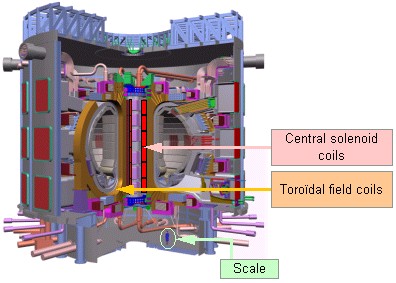
Figure 1 :
schematic view of ITER
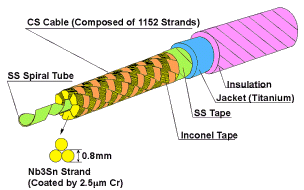
Figure 2 : structure of the TF insert conductor
|
In the course of the year 2000, the CS Insert test, carried out by Japan with a niobium-tin conductor representative of that intended for the Central Solenoid had enabled qualification of this type of circular section conductor and square section Incoloy
908 sheath. Indeed, it was possible to check
its proper working even with a current of 46 kA under magnetic induction of 13 teslas. The test also included the application of a cyclic load so as to represent the pulse working conditions of the Central Solenoid. A total of 10 000 cycles and several transitions (return to the
superconductor normal state) were carried out.
During the summer of 2001, an important
step in the qualification of manufacturing methods for the toroidal magnet (TF) had been completed with the tests of the
Toroidal Field Model Coil (TFMC), carried out by the European Union. Nevertheless, these tests did not fully qualify the niobium-tin conductor used,
since, although it was possible to reach a current of 80 kA, the maximum induction to which it was subjected did not exceed 7,8 T, while the toroidal field conductor should operate under 12,8 T.
| A new milestone has been reached with the tests on the TF Insert. |
|
Indeed, this Insert, made by the Russian Federation with a conductor comparable to that intended for the toroidal magnet coils, was tested from the September 17th to the October 19th 2001 in the CSMC in Naka. This conductor uses niobium-tin strands but a titanium sheath, while the TFMC conductor was made with a stainless steel sheath, similar to that intended for the ITER TF coil conductor. It was notably possible to check
its proper working under an induction of 13 T at a current of 46 kA. In addition, the first analysis of
the measurement results did not detect any deterioration after 2000 cycles and several transitions of the Insert .
|
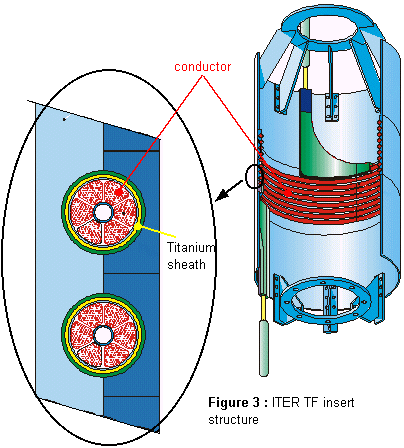
|
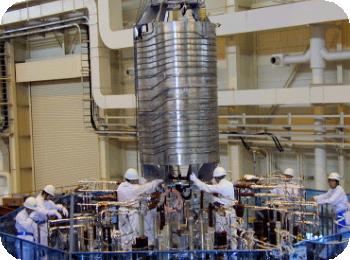 |
Figure 4: Insertion of the TF Insert in the CSMC in Naka on June 14th
2001 |
The TF Insert conductor, with
a circular cross-section of a 42,7 mm diameter, is made up of a cable containing a central channel
(diameter 10 mm) and 1152 strands of niobium-tin (diameter 0,81 mm), inserted in a thin titanium sheath
(2 mm thick). The tests led to an assessment of magnetic properties (magnetic losses under a variable field), electrical properties (critical current, current sharing
temperature) and mechanical properties (sensitivity to cycling).
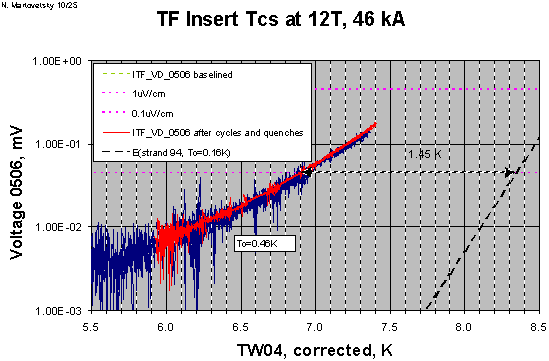
Figure 5 : Measurement of the current sharing temperature of the TF Insert before cycling: blue curve, after cycling: red curve
See also :
 Tests of the ITER toroidal field coil model
(07-09/2001) Tests of the ITER toroidal field coil model
(07-09/2001)
|
|